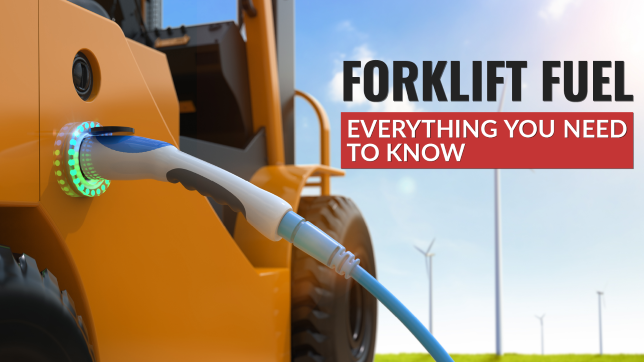Curious about the different forklift fuel types powering today’s lift trucks?
Then you’re in the right place.
Because in this post, you’ll learn everything you need to know, including:
- What all the forklift fuel types are
- Common specifications, pros/cons, applications, and prices of each
- How to choose the right forklift fuel type for your needs
- Answers to common forklift fuel questions
- And lots more…
Let’s dive in!
What Fuels Do Forklifts Run On?
Let’s answer the question right away…
Forklift fuels include:
- Electricity (lead-acid or lithium-ion batteries)
- Liquified petroleum gas (LPG, also just called “propane”)
- Gasoline
- Diesel
- Compressed natural gas (CNG)
- Hydrogen
Of these, electric and LPG are the most popular.
Forklift Fuel Types: Everything You Need to Know
Electric Forklifts
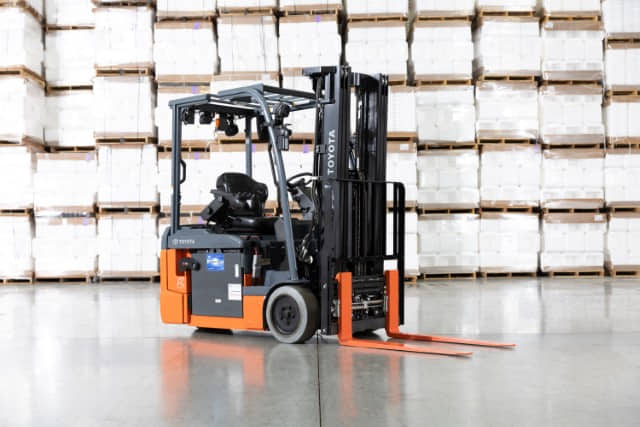
Electric forklifts are available in a variety of models and styles, including:
- Sit-down riders
- Stand-up riders
- Reach trucks
- Order pickers
- Pallet jacks
- Stackers
What each has in common is each is powered by electricity through a battery. That battery, however, can be one of two types: lead-acid or lithium-ion. Each of these technologies is different and offers different advantages and disadvantages. Let’s go through each type in more detail.
Lead-Acid Forklift Batteries
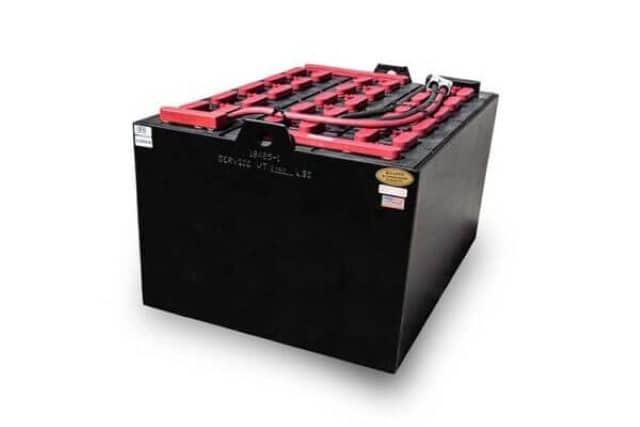
Lead-acid is the most common type of battery chemistry in use today. These batteries rely on a chemical reaction between lead plates and sulfuric acid to produce electricity.
Capacity
The typical lift capacity of lead-acid electric forklifts is 1,500 to 12,000 lbs. But there are larger models with 20,000 lbs. capacity.
Pros
- Environmentally friendly since they do not have exhaust emissions. This eliminates employees’ exposure to potentially harmful exhaust emissions.
- Produce low noise levels, making them ideal forklifts for indoor applications, small spaces, food processing environments, and cold storage.
- Reduced maintenance/repair costs: a simpler design with fewer moving parts means easier repairs and no disposal waste (i.e., engine and transmission fluid).
- Less noise and vibration are generated by the electric forklift, reducing operator fatigue.
- Cheap running costs and lower long-term fuel costs: Batteries for the electric forklift can be recharged and require low maintenance.
Cons
- Batteries can take a long time to recharge, especially lead-acid batteries. This can be problematic if you operate 24 hours a day.
- Require a dedicated battery charging station with dry, well-ventilated, and temperature-controlled conditions.
- May have a higher upfront cost than other types of forklifts (though this can be offset by long-term savings thanks to their lower maintenance costs and higher fuel efficiency)
Applications
- Warehouses
- Distribution centers
- Manufacturing facilities
- Retail stores
- Grocery stores
Price
Generally, electric forklifts with lead-acid batteries are more expensive than gas or diesel-powered forklifts.
Depending on the manufacturer, model, lifting capacity, and features, a new electric forklift can cost anywhere from $20,000 to $600,000 or more for the most specialized models.
Buying or leasing used electric forklifts can be purchased for less, with prices ranging from $5,000 to $100,000, depending on the age and condition of the equipment.
Lithium-Ion Forklift Batteries
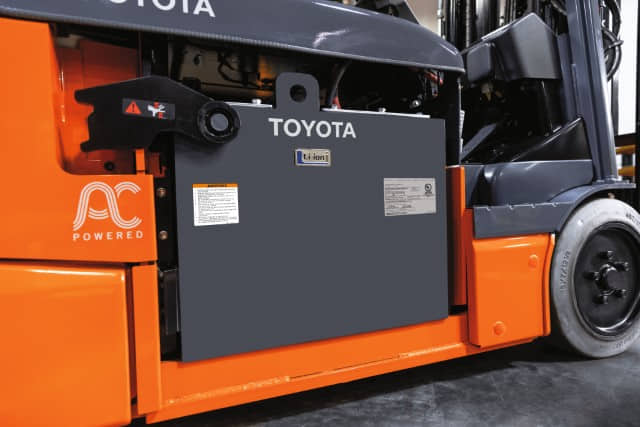
Many people are used to lithium-ion batteries, since many smartphones are powered by them. Now, they’ve made their way to powering forklifts. Much like their smaller counterparts, Li-ion forklift batteries offer longer run times and shorter charging cycles, while also lasting longer than lead-acid batteries.
Capacity
Lithium-ion batteries are available in practically any size that lead-acid batteries are. If a battery size isn’t immediately available, the manufacturer can often build one to your specification.
Pros
Forklifts powered by lithium-ion batteries have the same advantages as their lead-acid counterparts. But also Li-ion offers benefits that lead-acid batteries do not, like:
- Faster charging: Li-ion batteries can charge from 30% to 100% in as little as 1 hour. Fully charging a lead-acid battery via opportunity charging can take 4 to 6 hours.
- No maintenance: Lead-acid batteries require regular watering and general upkeep. Lithium-ion forklift batteries do not require watering or any maintenance.
- More productivity: Lead-acid forklifts slowly lose power as their battery drains. But Li-ion batteries maintain full power through to (near) the last “drop” of electricity
- Longer lifespans: Lead-acid batteries generally last 3 to 5 years when conventionally charged (that range drops dramatically if opportunity charged). Lithium-ion batteries can last 10 years, or even longer.
Cons
- High upfront cost: If not operating a multi-shift, 24/7 operation which can yield a faster return on investment (ROI), Li-ion may not make financial sense compared to lead-acid
- Requires devoted charging space: Though charging times are short, Li-ion forklifts require a space to be parked to charge. That’s space that could otherwise be used for other purposes
Applications
- Warehouses
- Distribution centers
- Manufacturing facilities
- Retail stores
- Grocery stores
- Cold storage
Price
Lithium-ion forklift batteries can cost twice as much as their lead-acid equivalents. Fortunately, most forklift chassis don’t require any modification to accept a lithium-ion battery.
Internal Combustion Forklifts
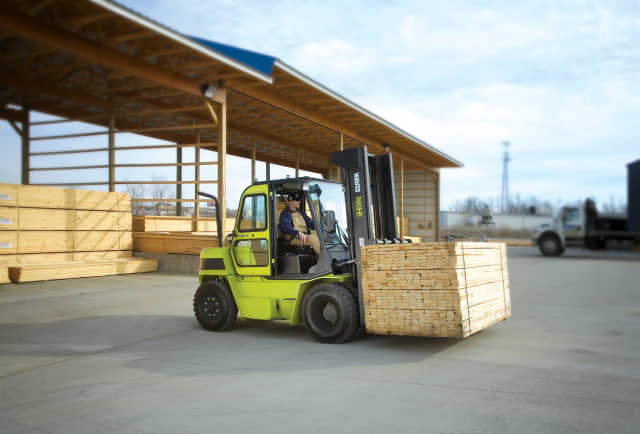
All internal combustion (IC) forklifts use an engine and combustible fuel for power. That said, they can be powered by a variety of fuel types. Let’s discuss each in more detail.
Liquefied Petroleum Gas (LPG) Forklifts
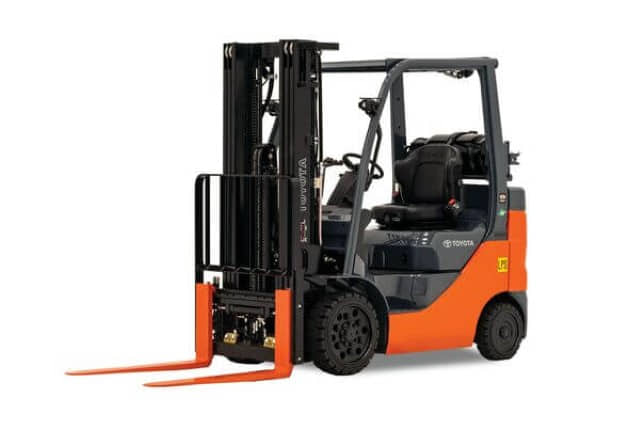
LPG has long been the chosen forklift fuel because of its wide availability, inexpensiveness, and ability to be used indoors
Liquefied petroleum gas (LPG) forklifts, also known as propane forklifts, are a popular type of material handling equipment powered by propane gas.
LPG forklifts are available with both cushion and pneumatic tires and can be great for indoor and outdoor operations.
Propane forklifts offer the advantage of being able to be used in a greater variety of environments and operations than electrics do.
Capacity
LPG forklifts are designed to lift and move heavy loads over short to medium distances.
Their lifting capacity range is typically from 3,000 lbs. to 15,000 lbs. Some LPG forklifts extend to 20,000 lbs.
Pros
- Lower upfront cost than electric forklifts: all you essentially need is the lift truck itself, some LP tanks, and a place to store them
- Fuel cost is typically lower than diesel-powered forklifts
- More environmentally friendly than diesel-powered forklifts, as they emit fewer pollutants
- More versatile than electric forklifts because they can be used both indoors and outdoors
- LPG tanks can be swapped in minutes, reducing downtime when refueling
Cons
- Require a propane tank, which can put workers at risk, has less fuel capacity than an internal tank, and adds to the cost of maintenance
- Higher maintenance costs than electric forklifts since they have more moving parts
- Noisy and require more ventilation than electric forklifts, which could be a concern in some indoor applications
- Require fuel tank storage space and the services of a propane refueling company
Applications
LPG forklifts are used in a wide range of applications, including:
- Warehouses
- Distribution centers
- Manufacturing facilities
- Construction sites
Liquid petroleum gas (LPG) is ideal for locations that do not have gasoline, diesel, or CNG refilling stations readily available.
Price
Generally, LPG forklifts are less expensive than their equivalent electric and diesel-powered models.
For example, a new LPG forklift can cost anywhere from $15,000 to $50,000 or more. On the other hand, used LPG forklifts can be purchased for less. Their prices can range from $5,000 to $20,000, depending on the age and condition.
Gasoline Forklifts
Gasoline-powered forklifts are rare due to the popularity of electric and LPG forklifts and the more cumbersome refueling requirements.
This is why they’re preferred by operators with refueling stations readily available, conveniently placed, and able to accommodate the size of their fleet.
Capacity
Gasoline forklifts have lifting capacities ranging from 3,000 to 15,500 lbs.
Pros
- Can lift heavy loads quickly and efficiently, making them an ideal choice for demanding work environments.
- Can be used in a variety of applications, including construction, manufacturing, and warehousing.
- Do not have an LPG tank and bracket on the back of the forklift, which can increase rearward visibility.
Cons
- Gasoline forklifts are typically more expensive to operate than electric forklifts.
- Typically less powerful than their diesel counterparts and can’t provide as fast travel and lift/lower forklift speeds.
- They produce emissions, which can be harmful to the environment and pose a health risk to workers in poorly ventilated areas.
Applications
Overall, gasoline forklifts shouldn’t be used indoors, making them better for outdoor applications like
- Construction
- Rigging
- Oil/gas
- Agriculture
- Utilities
- Railways
Price
The price of gasoline forklifts varies based on the model, lifting capacity, and features.
Lighter gasoline forklifts can cost anywhere from $10,000 to $20,000, while heavy-duty models can cost upwards of $50,000.
In addition to the initial purchase price, companies will also need to factor in ongoing fuel and maintenance costs when considering the total cost of ownership for a gasoline forklift.
Dual-Fuel Forklifts
Dual-fuel forklifts are those equipped with both LPG (propane) and gasoline fuel systems. They can be run on either of the fuel types but not at the same time.
Dual-fuel forklifts are available in various styles and lifting capacities to meet different industries’ needs, with indoor and outdoor models. This makes them versatile enough to handle various applications.
Capacity
Most dual-fuel forklifts are designed to lift loads ranging from 3,000 to 15,000 lbs. But larger models are available for heavier lifting applications.
Pros
- More fuel-efficient compared to traditional gasoline-only forklifts. They consume less fuel and have longer run times.
- Fewer pollutants are emitted compared to gasoline-only forklifts, making them a more environmentally-friendly choice.
- The ability to switch between gasoline and propane fuel sources offers more flexibility, depending on the application, availability, and cost of each fuel.
- Dual-fuel forklifts typically have longer lifespans than gasoline-only forklifts due to their reduced wear and tear on the engine.
Cons
- Higher upfront cost: Dual-fuel forklifts are generally more expensive than traditional gasoline-only forklifts. This is due to the added technology and materials required for dual-fuel capabilities.
- More maintenance: Dual-fuel forklifts require more maintenance than traditional gasoline-only forklifts due to the added components needed for dual-fuel operation.
Applications
- Manufacturing
- Warehousing
- Construction
- Agriculture
Dual-fuel forklifts are especially useful in applications that require flexibility in fuel choices and where emission reductions are a concern.
Price
Dual-fuel forklifts typically cost more than traditional gasoline-only forklifts. Prices can range from $20,000 to $60,000 depending on the model, capacity, and features.
Given the fuel savings and extended lifespan, these savings may offset the higher initial cost in the long run.
Diesel Forklifts
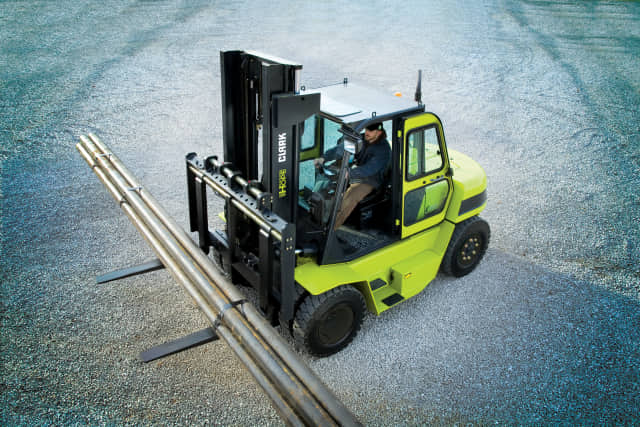
Generally, diesel lift trucks are only available with pneumatic-type tires and are designed for outdoor use. This is mainly because they are louder machines and produce more emissions than LP or gas-powered forklifts.
The sturdy designs of diesel forklifts allow for power and versatility in many industries, from construction and agriculture to recycling and transportation.
Capacity
Diesel forklifts are available in a wide range of models and styles, with lifting capacities that range from around 3,000 lbs. up to over 40,000 lbs.
There are also heavier-capacity diesel forklifts capable of lifting over 125,000 lbs., like this Toyota High-Capacity IC Pneumatic Diesel Forklift.
Diesel forklifts are known for their high torque, which allows them to handle heavy loads and operate on rough terrain.
Pros
- Off-road diesel forklifts provide greater stability on uneven terrain
- Can work longer without running out of fuel. Refueling them is also easier, faster, and less injury-prone than changing LPG tanks or charging batteries.
- Can move heavier, bigger loads than electric or gas forklifts, and can also accelerate faster.
- Higher torque: Diesel forklift truck engines have higher power outputs than other types of forklifts. This makes them ideal for lifting bigger loads and navigating gradient surfaces.
- Known for their long service life, making them cost-effective businesses that require heavy lifting equipment.
- Don’t require extra space for battery charging stations. They can be refilled directly from the tank.
Cons
- Higher maintenance costs than electric lifts because of more moving parts.
- More expensive to operate in the long run. Diesel forklifts generally need to be replaced every eight years, as opposed to electric lifts that can often run for 12 years.
- Limited maneuverability compared to electric lifts.
- Emissions restrict indoor use. OSHA requires that you “Do not operate in a poorly ventilated area where vapors can concentrate.”
Applications
- Construction sites
- Shipping yards
- Railways
- Agriculture
- Oil/gas
- Lumber yards
- Utilities
Price
On average, new diesel forklifts can cost between $20,000 and $50,000, depending on weight capacity. Some models can cost more due to advanced features such as GPS tracking, specialized attachments, or ergonomic cabs.
Compressed Natural Gas (CNG) Forklifts
Natural gas forklifts run on compressed natural gas (CNG), which is made of compressed and filtered methane.
These models are becoming increasingly popular as companies seek to reduce their carbon footprint and lower their operating costs. They produce much less carbon monoxide than gasoline or diesel forklifts, which can help companies meet OSHA requirements for indoor air quality.
There are various models and styles of CNG forklifts available on the market, including both counterbalance and narrow aisle models.
Capacity
The lifting capacity of CNG forklifts ranges from 3,000 to 55,000 lbs.
Pros
- Environmentally friendly, producing fewer emissions and resulting in improved air quality in the working environment.
- No need to remove the CNG tank to refill it. This makes refueling easy, fast, and resizable – typically under five minutes!
- Overall maintenance costs are among the lowest of various forklift fuel types. They have few moving parts and require few repairs.
- Since the engines are less corrosive, they can last longer than other fuel/engine combinations.
- CNG fuel is often cheaper than gasoline or diesel, which can lead to cost savings over time.
Cons
- CNG has the highest upfront cost, compared to propane and gasoline
- Not as widely available, making replacement parts more expensive.
- Need more fuel to produce the same amount of energy as other forklift fuel types, meaning the operator will refill more often.
- Due to more fuel needs, fuel storage takes up more space than propane or gasoline.
- May require more maintenance than traditional forklifts, as they have a relatively more complex fuel system.
Applications
- Warehouse
- Distribution centers
- Manufacturing
- Ports
CNG forklifts are particularly useful in indoor environments, as they produce fewer emissions and are quieter than traditional forklifts.
Price
Expect CNG forklifts to be more expensive than traditional LPG or electric forklifts. Also, be aware of the additional cost of installing a dedicated fueling station.
Hydrogen Forklifts
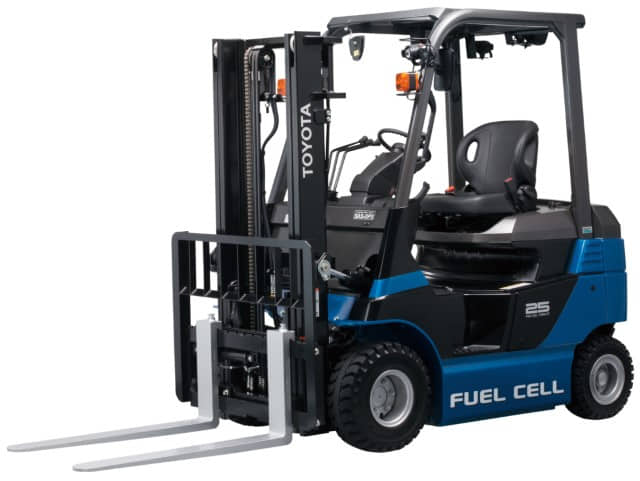
Hydrogen forklifts are powered by hydrogen fuel cells instead of traditional lead-acid batteries or internal combustion engines.
A forklift hydrogen fuel cell is a cell producing an electric current as a direct result of a chemical reaction. The chemical reaction produces electricity used to power a load which, in this case, is a forklift.
These forklifts have gained popularity in recent years due to their efficiency, lower environmental impact, and lower operating costs.
Capacity
Hydrogen forklifts are available in a variety of models and styles, ranging from compact models with lifting capacities of 2,000 lbs. to larger models with lifting capacities of up to 33,000 lbs.
They come in stand-up, sit-down, and walkie styles, and some models are designed specifically for narrow aisles and tight spaces.
Pros
- Hydrogen forklifts typically have a longer run time than other forklift fuel types.
- Faster refueling times compared to electric or traditional gas-powered forklifts, allowing greater productivity and reduced downtime.
- Zero-emission operation, which makes them a cleaner and more sustainable alternative to traditional forklifts.
- Hydrogen fuel cells are more efficient than traditional lead-acid batteries, resulting in lower operating costs over time.
- Can operate in cold temperatures without the need for frequent battery changes.
Cons
- High upfront cost than lead-acid, which can be a barrier for some businesses.
- The infrastructure for hydrogen refueling is not as widespread as traditional gasoline or electric charging stations.
Applications
- Manufacturing
- Distribution
- Logistics
- Warehousing
- Cold storage
Price
Hydrogen forklifts are more expensive than electric and other IC forklifts with different fuel types. On average, hydrogen forklift costs can range from $50,000 to $100,000.
What Is the Best Fuel for Forklifts? 6 Questions to Help You Decide
Determining the best fuel for your forklift depends on your application, fuel availability, budget, and more. Let’s go through each factor in a bit more detail so you can make an informed decision.
- How much weight-lifting capacity do you need? Internal combustion forklifts – especially diesel-powered models – tend to offer higher lifting capacity than electric forklifts.
- Will you use it indoors, outdoors, or both? Choose forklifts that can operate in wet areas like LPG, gasoline, or diesel. Electric and hydrogen forklifts may be a good choice if you’ll be operating in cold rooms.
- How much space do you have available? For example, electric forklifts require a charging room, while CNG forklifts require dedicated spaces for storing gas cylinders. Do you have space for charging or storage? Consider the space you have before making a choice.
- What type of terrain will you use it on? Diesel pneumatic forklifts are ideal for uneven/rough grounds or outdoor and large open spaces (e.g., docks, construction sites, industrial) compared to electric, gas, or hydrogen forklifts. Make sure you understand your terrain before you settle on the forklift.
- What is your fuel availability? In other words, where will you get your forklift fuel? Can you easily/cheaply get LPG gas? What about gasoline? Diesel? If the answer to these questions is negative, then an electric forklift may be better. You’ll also need to consider long-term costs, such as electricity over time versus refueling services.
- Are you concerned about emissions? Internal combustion forklifts can give off a lot of pollution. Especially diesel-powered forklifts. Propane forklifts also produce emissions and may be less environmentally-friendly than other fuel types. Electric, natural gas, and hydrogen forklifts produce fewer emissions, though only if how they are generated doesn’t produce an offsetting amount of pollution. If your budget allows, consider going for low-emission forklifts that can help you protect your forklift operators, workers, and the environment.
All Forklift Fuel Types Compared
Here’s a simple comparison of all the forklift fuel types: electric vs. LPG vs. gasoline vs. diesel vs. CNG vs. hydrogen forklifts:
| Criteria | Electric | LPG | Gasoline | Diesel | CNG | Hydrogen |
|---|---|---|---|---|---|---|
| Environments | Indoor & outdoor | Indoor & outdoor | Indoor & outdoor | Outdoor only | Indoor & outdoor | Indoor (preferably) |
| Lifting capacities | Small to medium | Small to medium | Small to medium | Heavy | Small to medium | Small to medium |
| Emissions | None | Low | Low | High | Low | None |
| Noise | Low | Medium-high | Medium-high | Medium-high | Low | Low |
| Refueling speed | Fast-slow (1-8 hours) | Fast | Medium | Medium | Medium | Fast |
| Fuel availability | Wide | Medium-wide | Wide | Wide | Low | Low |
| Maintenance | Minimal | Regular | Regular | Regular | Minimal | Minimal |
| Market availability | Wide | Wide | Uncommon | Less common | Uncommon | Rare |
| Cost | Higher upfront, lower overall | Lower upfront, higher overall | Lower upfront, higher overall | Higher upfront, higher overall | Higher upfront, lower overall | Higher upfront, lower overall |
Need more help deciding which forklift fuel type is right for you? Contact us today. We’ll be glad to lend a hand.
Common Forklift Fuel Questions
What Fuel Do Forklifts Use?
Forklifts use different fuel types including electricity, propane (LPG), diesel, gasoline, compressed natural gas (CNG), and hydrogen.
Are Forklifts Gas or Propane?
Forklifts can be gas or propane (LPG) or they can be dual-fuel (if in the same truck). Dual-fuel forklifts are less common. Forklifts can also be electric, gasoline, or hydrogen. Electric and LPG forklifts are the most common.
What Type of Propane Do Forklifts Use?
Forklifts use “liquified petroleum gas” (LPG), commonly known as propane.
Do Forklifts Run on Liquid Propane?
Most forklifts run on liquid LPG, which is commonly called propane. Air-cooled forklifts (those without a radiator) use vapor LPG, which comes in the familiar “BBQ”-style tank.
Why Do Forklifts Use Propane?
Some of the top reasons why many forklifts use propane instead of gas are because propane:
- Has fewer emissions
- Burns fuel cleaner
- Is cheaper to produce
- Is easier to transport
Propane allows forklifts to run on 100% power throughout operation, boosting productivity, especially during forklift outdoor operations where higher speeds are allowed. Also, propane engines can last up to 2X as long as their gasoline counterparts, saving you money on maintenance. See our electric vs. propane forklifts article for more benefits of propane as a forklift fuel source.
How Long Will a Forklift Run on Propane?
On average, a 33 lbs. propane tank (the size used in the majority of forklifts) can last up to eight hours. Though, 4 to 6 hours is more common. The actual duration depends on the age of the forklift, how it’s used, the size of the loads handled, the kind of shape the truck is in mechanically, the terrain operated on, and other factors.
How Many Gallons of Propane Does a Forklift Use per Hour?
The average forklift fuel consumption should be about 0.7 gallons (approx. 6 lbs.) of LPG propane per hour. About 90% of propane-fueled forklifts utilize an 8-gallon (or 33 lbs.) propane tank that can last up to eight hours. Some larger forklifts run on a 10-gallon (43 lbs.) propane tank to fuel their larger engines.
What Are Liquified Petroleum Gas (LPG) Forklift Emissions?
The newest propane forklift models can produce as low as 5% carbon monoxide (CO) exhaust gas concentration when tested at the tailpipe. If the forklift is an older model or poorly maintained, the tailpipe output percentage could be higher. Overall, LPG forklifts produce low oxides of nitrogen (NOX), carbon monoxide (CO), and total hydrocarbon (THC) emissions, while emitting less carbon dioxide (CO2) and particulates.
Why Is My Gas Forklift Hard to Start?
The most common cause is that the forklift is too cold. The solution is that you bring the tank (and ideally the lift truck, if you can move it at all) inside to warm up, then try again.
Another common issue for forklifts that will turn over but won’t start is the spark plugs. If you have a spark tester, you can check the strength of the spark. If the spark is weak and yellow, the plug may need replacing. A good spark is a solid blue spark.
See our Common Forklift Repairs post for causes/solutions of common no-start scenarios. You can also see the Propane Forklift Engine Troubleshooting Guide for possible solutions.
Are Forklifts Gas or Diesel?
Forklifts can be either gas or diesel but they can’t be both. Each engine/fuel type works too differently not to be separate. Forklifts can also be LPG, hydrogen, electric, or compressed natural gas.
Are Forklifts Powered by Diesel?
Some forklifts are powered by diesel fuel. Diesel forests are usually heavy-duty and have a higher lifting capacity. For Toyota forklifts, any model containing the letter “D” designates a “diesel” fuel type. For example, a Toyota model 8FDU25 is a 5,000 lb. capacity diesel forklift with pneumatic tires. Read more about Toyota forklift models.
Why Won’t My Diesel Forklift Start?
There are different reasons why your forklift won’t start:
Check the Glow Plugs
Glow plugs are “warmers” located inside the combustion chamber in diesel engines designed to heat the space and make it easier for fuel to combust. They’re required because diesel forklifts don’t start well with cold combustion chambers. Be aware: the solution to this can vary by model. For example, on a Toyota diesel, turn the ignition to the “On” position – look for the glow plug indicator to cycle – then try to start.
Check the Battery
If the glow plugs don’t solve the problem, check the battery. Make sure it’s charged and properly connected. If not, try jumping or recharging it. If the battery can’t charge, it might need replacing. You should also check that the battery is not too cold. Just like a car, a forklift battery can struggle to get going in minus temperatures. Move the battery in to warm up.
If these actions don’t work, contact your local authorized service center.
Who Are the Top Forklift Gas Suppliers?
The top American LPG suppliers include AmeriGas, FerrellGas, Energy Distribution Partners, and 21st Century Energy Group. You can find other forklift gas suppliers here.
How Do You Handle a Gas or Diesel Forklift Fuel Spill?
In case of a fuel spill, apply sand, straw, sawdust, ground corn cobs, or commercial absorbents such as kitty litter or oil dry. Rather than wash them away with water, this helps to absorb petroleum residues. Absorbent materials used to clean up fuel spills may be disposed of at a sanitary landfill with prior approval of the landfill operator.
Conclusion
That’s it: Everything you need to know about forklift fuels.
